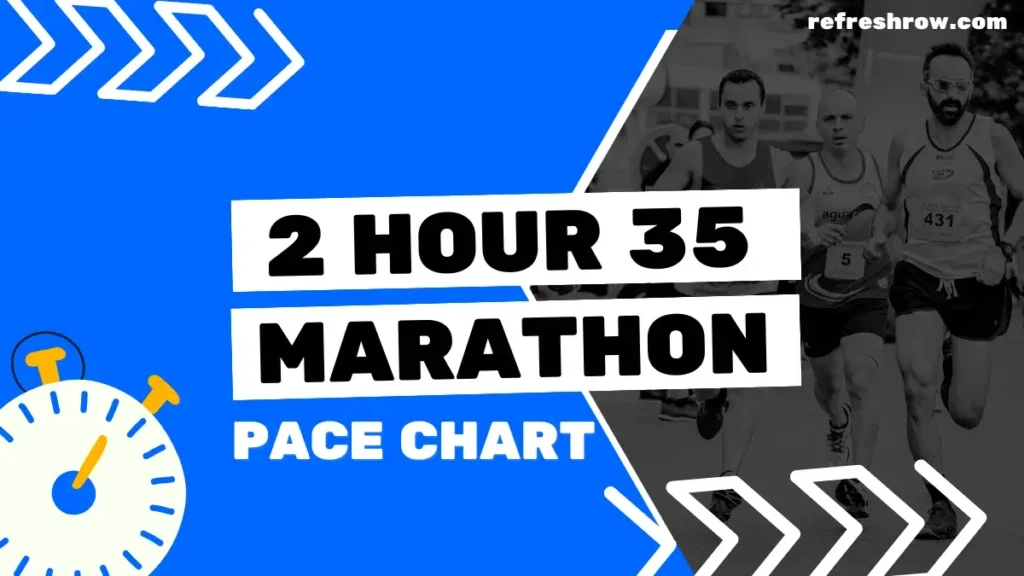To run a 3:10 hour marathon you need to run at a pace of 7:15 per mile or 4:30 per kilometer.
Following the splits below (and shaving off a second), you’ll run a sub 3:10 marathon.
I’d recommend aiming to run 1-2 minutes ahead of the split target time from 10 miles, as you’ll likely come up against crowding on race day.
3:10 Marathon Pace in Miles
| Mile | Split |
|---|---|
| 1 | 7:15 |
| 2 | 14:30 |
| 3 | 21:44 |
| 4 | 28:59 |
| 5 | 36:14 |
| 6 | 43:29 |
| 7 | 50:44 |
| 8 | 57:58 |
| 9 | 1:05:13 |
| 10 | 1:12:28 |
| 11 | 1:19:43 |
| 12 | 1:26:58 |
| 13 | 1:34:12 |
| 14 | 1:41:27 |
| 15 | 1:48:42 |
| 16 | 1:55:57 |
| 17 | 2:03:12 |
| 18 | 2:10:26 |
| 19 | 2:17:41 |
| 20 | 2:24:56 |
| 21 | 2:32:11 |
| 22 | 2:39:26 |
| 23 | 2:46:40 |
| 24 | 2:53:55 |
| 25 | 3:01:10 |
| 26 | 3:08:25 |
| 26.2 | 3:10:00 |
Download
3:10 Marathon Pace in KM
| KM | Split |
|---|---|
| 1 | 4:30 |
| 2 | 9:00 |
| 3 | 13:31 |
| 4 | 18:01 |
| 5 | 22:31 |
| 6 | 27:01 |
| 7 | 31:31 |
| 8 | 36:01 |
| 9 | 40:32 |
| 10 | 45:02 |
| 11 | 49:32 |
| 12 | 54:02 |
| 13 | 58:32 |
| 14 | 1:03:02 |
| 15 | 1:07:33 |
| 16 | 1:12:03 |
| 17 | 1:16:33 |
| 18 | 1:21:03 |
| 19 | 1:25:33 |
| 20 | 1:30:03 |
| 21 | 1:34:34 |
| 22 | 1:39:04 |
| 23 | 1:43:34 |
| 24 | 1:48:04 |
| 25 | 1:52:34 |
| 26 | 1:57:05 |
| 27 | 2:01:35 |
| 28 | 2:06:05 |
| 29 | 2:10:35 |
| 30 | 2:15:05 |
| 31 | 2:19:35 |
| 32 | 2:24:06 |
| 33 | 2:28:36 |
| 34 | 2:33:06 |
| 35 | 2:37:36 |
| 36 | 2:42:06 |
| 37 | 2:46:36 |
| 38 | 2:51:07 |
| 39 | 2:55:37 |
| 40 | 3:00:07 |
| 41 | 3:04:37 |
| 42 | 3:09:07 |
| 42.2 | 3:10:00 |
Download
Other Marathon Pace Charts
Targeting a different time?
Check out the Full Marathon Pace Chart in Miles or KM
Or select a specific finishing time below:
| 3:00 | 4:00 | 5:00 | |
| 3:05 | 4:05 | 5:15 | |
| 3:10 | 4:10 | 5:30 | |
| 3:15 | 4:15 | 5:45 | |
| 3:20 | 4:20 | 6:00 | |
| 3:25 | 4:25 | 6:15 | |
| 2:30 | 3:30 | 4:30 | 6:30 |
| 2:35 | 3:35 | 4:35 | 6:45 |
| 2:40 | 3:40 | 4:40 | 7:00 |
| 2:45 | 3:45 | 4:45 | |
| 2:50 | 3:50 | 4:50 | |
| 2:55 | 3:55 | 4:55 |
Training for a 3:10 Marathon
Is 3:10 a Good Marathon Time?
Well, what do the stats say?
Run Repeat conducted a study that contains 19,614,975 marathon results from more than 32,335 races across the globe, here is how a 3:10 marathon compares against age and gender for the races recorded:
| Overall | You’re faster than 96.5% of all runners. |
| Male | You’re faster than 94.6% of males. |
| Female | You’re faster than 99.1% of females. |
| <20 | You’re faster than 93.8% of under 20s. |
| 20-29 | You’re faster than 94.0% of 20-29 year olds. |
| 30-39 | You’re faster than 95.1% of 30-39 year olds. |
| 40-49 | You’re faster than 97.4% of 40-49 year olds. |
| 50-59 | You’re faster than 99.1% of 50-59 year olds. |
| >60 | You’re faster than 99.8% of over 60s. |
Training Runs and Paces for a 3:10 Marathon
To break a 3:10 marathon you’ll need to do some serious distance in your training, I recommend at least 35 miles (56km) per week.
You’re also going to need to make sure you’ve crossed off these milestones for other race distances:
- A 5k in 19:50 mins
- A 10k in 41:10 mins
- A half marathon in 1 hour 27 mins
Training Paces
| Pace | Mins per Mile | Mins per KM |
|---|---|---|
| Easy | 8:10 | 5:04 |
| Steady | 7:15 | 4:30 |
| 10k | 6:38 | 4:07 |
| 5k | 6:22 | 3:57 |
| 1 Mile | 5:55 | 3:42 |
Weekly Mileage Targets
| Target Mileage: | Gradually increase your weekly mileage from 40 miles (64 km) to a peak of 68 miles (109 km). |
| Incremental Increase: | Increase mileage by approximately 10% each week, with every fourth week as a recovery week where mileage is reduced by 20-30%. Make sure to taper for the last 1-2 weeks. |
Long Run Structure
| Total Distance: | Build up to long runs of 20-22 miles (32-35 km). |
| Segment Example: | First 5 miles (8 km): Easy pace, heart rate 140-150 bpm (approximately 8:15/mile or 5:07/km). Next 1 mile (1.6 km): Fast pace at 6:10/mile (3:50/km). Next 5 miles (8 km): Medium effort, heart rate around 160 bpm (approximately 7:10/mile or 4:27/km). Repeat: Repeat the segment twice (5 miles easy, 1 mile fast, 5 miles medium), you can taper the final 2 miles if required. |
Why This Works: Incorporating varied paces within long runs enhances lactate tolerance, which helps on race day when you’ve got to maintain pace despite feeling fatigued. By practicing surges during a run, you can build up your physical and mental resilience (lots of elite marathon runners use these strategies during their training)
Alternating Long Runs: Alternate between structured long runs (easy/fast segments) and easier long runs. For easier long runs, maintain a steady, comfortable pace throughout, focusing on mileage rather than speed to aid recovery.
Speedwork Sessions
| Short Intervals: | – 800m repeats at 3:05 per interval (3:50/km). – Aim for 6-12 repetitions with equal time for recovery. |
| Mile Repeats: | – 1 mile repeats at 6:10 per mile (3:50/km). – Aim for 6-12 repetitions with a 1-2 minute recovery jog. |
| Longer Intervals: | – 2 mile repeats at 6:20 per mile (3:56/km). – Aim for 5-8 repetitions with a 2-3 minute recovery jog. |
Recovery and Rest Days
| Rest Days: | You don’t need to incorporate rest days if you are using recovery runs, but I recommend taking 1 (or a max of 2) per week to allow your body to recover and prevent overtraining. |
| Easy Run Days: | Include 1-2 easy run days per week at a relaxed pace of 8:30/mile (5:17/km), covering 5-10 miles (8-16 km) per day. Try to keep your heart rate below 140 bpm on easy days to ensure proper recovery and aerobic development. |
My Tips to Run a Sub 3:10 Marathon
Implement Strength and Flexibility Workouts
Strength training and flexibility workouts help by enhancing running economy and reducing injury risk.
Incorporating strength exercises like squats, lunges, deadlifts, and planks into your routine 2-3 times a week will fortify your core, legs, and hips.
Flexibility workouts, including dynamic stretches before and static stretches after runs, maintain the necessary range of motion and prevent muscle tightness.
Additionally, integrating yoga or Pilates sessions 1-2 times per week can improve overall flexibility and core strength, which are beneficial for maintaining form and efficiency during the marathon.
Optimize Nutrition and Hydration Strategies
Ensure your daily diet is balanced with complex carbohydrates, lean proteins, and healthy fats, aiming for 6-8 grams of carbohydrates per kilogram of body weight in the week leading up to the race.
Practice your race day fueling strategy during long runs, consuming 30-60 grams of carbohydrates per hour through gels, chews, or sports drinks.
Adequate hydration is equally important; hydrate well in the days before the race and drink fluids regularly during the marathon, aiming for 150-250 ml every 20 minutes, adjusting based on weather conditions and personal sweat rate.
Focus on Mental Toughness and Race Day Strategy
Mental toughness and a well-thought-out race day strategy really help me overcome the physical and psychological challenges of a marathon.
Employ visualization techniques to mentally prepare, imagining yourself running strong through difficult segments and achieving your goal time.
Start the race conservatively, adhering to your planned pace for the first half and running slightly slower than your target if necessary.
Aim to reach the 20-mile mark feeling strong, then gradually increase your effort from miles 20-26. Prepare for race day variables such as weather and crowding, adjusting your strategy as needed.
Positive self-talk and mantras can also keep you motivated and focused during tough parts of the race, helping you maintain resilience and determination to achieve your 3:10 marathon goal.


Row Brown is the founder of Refresh Row. He is a keen marathon runner, his favorite being the London Marathon. He’s now set himself the mission of Running the Entire Length of Spain, which is scheduled for late 2024.


